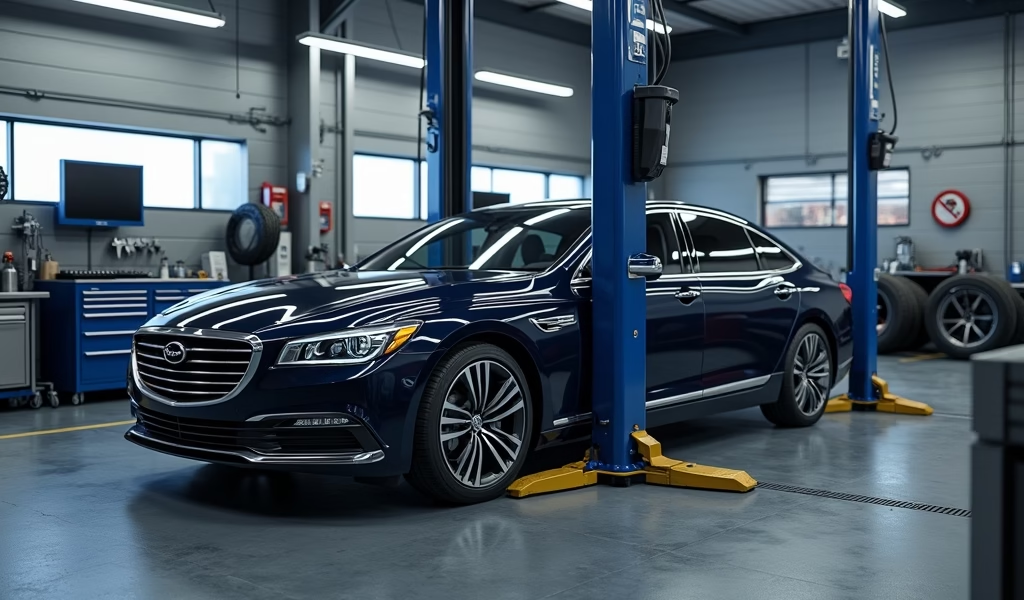Overview
This article presents seven essential car maintenance hacks for American drivers, including regular oil changes, proper tire care, fluid monitoring, air filter maintenance, battery upkeep, brake inspection techniques, and creating a preventive maintenance schedule. By consistently implementing these straightforward practices, drivers can extend their vehicles’ lifespan, improve safety, and save thousands of dollars in repair costs over time.
Table of Contents
- Introduction to Car Maintenance in America
- Hack #1: Master the Art of Regular Oil Changes
- Hack #2: Simple Tire Care That Saves Thousands
- Hack #3: Monitoring Fluid Levels Like a Pro
- Hack #4: Air Filter Maintenance Made Easy
- Hack #5: Battery Maintenance Secrets
- Hack #6: DIY Brake Inspection Techniques
- Hack #7: Creating a Preventive Maintenance Schedule
- Conclusion
- Frequently Asked Questions
Introduction to Car Maintenance in America
When it comes to keeping your vehicle running smoothly on America’s vast roadways, a little know-how goes a long way. Here at Car America, I’ve spent over 15 years helping drivers get more miles from their vehicles while spending less at the repair shop. The average American drives almost 13,500 miles annually, putting significant wear and tear on their vehicles. But here’s the good news: with some simple maintenance hacks, you can extend your car’s life and avoid those expensive, unexpected breakdowns.
The secret? Consistency beats complexity every time. You don’t need to be a mechanical genius to maintain your car effectively. What matters most is developing regular habits that protect your domestic car investment. Whether you’re driving a brand-new sedan or a trusted family SUV that’s seen better days, these seven proven maintenance techniques will help you keep that engine purring for years to come.
Let’s roll up our sleeves and dive into these car care essentials that every driver in Car America should know. Trust me – your wallet will thank you later!
Hack #1: Master the Art of Regular Oil Changes
Think of engine oil as your car’s lifeblood. Without clean, quality oil flowing through its system, your engine starts struggling – leading to decreased performance and potentially catastrophic damage. In my years as a mechanic, I’ve seen too many engines fail prematurely simply because someone skipped a few oil changes.
For most vehicles in Car America today, changing your oil every 5,000 to 7,500 miles works perfectly. However, if you’re driving in extreme conditions (very hot climates, lots of stop-and-go traffic, or hauling heavy loads), you might need to change it more frequently. Always check your owner’s manual for the manufacturer’s specific recommendations for your make and model.
Want to save some cash? Learning to change your oil yourself is surprisingly simple. You’ll need:
- The correct oil type and amount for your vehicle
- A new oil filter
- Basic tools (wrench, oil catch pan, funnel)
- Jack stands or ramps for safe access
Even if you prefer leaving oil changes to the professionals, always keep track of your mileage between changes. I recommend putting a small sticker in the corner of your windshield with the mileage due for your next change. This tiny habit alone can add years to your engine’s lifespan and improve your fuel efficiency by up to 2%.
Hack #2: Simple Tire Care That Saves Thousands

Your tires are literally where the rubber meets the road, yet most Car America drivers I meet neglect these crucial components. Did you know that properly maintained tires can save you up to $0.11 per gallon in fuel costs? That adds up to hundreds of dollars annually for the average driver!
First, check your tire pressure monthly. Underinflated tires not only waste fuel but also wear out faster and can be dangerous in emergency maneuvers. You’ll find the correct pressure (PSI) listed in your owner’s manual or on a sticker inside the driver’s door jamb – not the number on the tire sidewall, which is actually the maximum pressure, not the recommended one.
Rotation is your next tire-saving strategy. Every 5,000-7,000 miles, have your tires rotated to ensure even wear patterns. This simple step can double your tire life, saving you from premature replacements that can cost $600-$800 per set. For those of you wondering where is the best place to buy a used car, many reputable dealers will throw in free tire rotations as part of their service package.
Finally, check your alignment yearly or whenever you notice your car pulling to one side. Poor alignment rapidly destroys tire tread and hampers fuel economy. Most alignment shops in Car America offer free alignment checks – take advantage of this to catch problems early.
My personal tire hack? Keep a quality pressure gauge in your glove compartment and check your tires whenever you fill up with gas. This five-minute habit saved me from a blowout on a family road trip last summer when I caught a slow leak before it became dangerous.
Hack #3: Monitoring Fluid Levels Like a Pro
Your car relies on several critical fluids to function properly, and checking them regularly is one of the easiest ways to prevent major mechanical failures. I like to call this my “five-fluid check,” and I recommend doing it monthly or every other fuel fill-up if you drive frequently.
Engine oil isn’t the only vital fluid – your transmission fluid, brake fluid, power steering fluid, and coolant all play crucial roles in keeping your car running safely. Most of these have transparent reservoirs under the hood with “MIN” and “MAX” markings, making visual inspections quick and simple.
For transmission fluid, many newer vehicles have sealed systems that don’t require regular checks, but for older Car America models with dipsticks, check this fluid while the engine is running and warm (unlike oil, which you check cold). The fluid should be a clear red color – if it’s brown or smells burnt, it’s time for a change.
Coolant levels are particularly important to monitor as seasons change. Before summer heat hits, make sure your coolant is at the proper level and concentration to prevent overheating. Similarly, before winter, ensure your coolant has the right freeze protection for your climate. According to NHTSA research, cooling system failures are among the top causes of vehicle breakdowns.
Windshield washer fluid might seem minor, but running out at the wrong moment can seriously compromise visibility and safety. I keep a gallon in my garage and top off monthly – it’s an inexpensive habit that’s saved me from dangerous driving conditions more than once.
Hack #4: Air Filter Maintenance Made Easy
Your car’s engine needs to breathe clean air just like you do. A clogged air filter can reduce acceleration by up to 11% and increase fuel consumption significantly. The good news? Checking and replacing your air filter is one of the simplest maintenance tasks you can perform yourself.
Most Car America vehicles have air filters housed in an easily accessible plastic box under the hood, secured with clips or a few screws. Open it up every 15,000 miles or so (more frequently if you drive on dusty roads) and hold the filter up to a light source. If you can’t see light passing through it, it’s time for a replacement.
Air filters typically cost between $15-$30 at auto parts stores, but dealerships might charge $50-$100 for the same service. This is one area where doing it yourself really pays off! While you’re at it, don’t forget about your cabin air filter, which keeps the air inside your car clean. This is usually located behind the glove compartment and should be replaced annually for better air quality and more efficient heating and cooling.
My pro tip: Mark your calendar to check both filters every six months, perhaps when daylight saving time changes – this creates an easy-to-remember schedule. For most drivers in Car America, this simple habit alone can save over $100 annually in unnecessary service charges and improved fuel economy.
If you own a Chevrolet vehicle, you’ll find their air filter boxes particularly user-friendly, often requiring no tools to open and inspect. This makes maintenance even more convenient for Chevy owners.
Hack #5: Battery Maintenance Secrets

Battery failures consistently rank among the top three reasons for roadside assistance calls across Car America. Yet with minimal effort, you can significantly extend your battery’s life beyond the typical 3-5 year span.
First, keep those terminals clean. Battery terminals naturally accumulate corrosion – that white, powdery substance that restricts electrical flow. Every few months, disconnect the cables (always negative/black first) and clean the terminals with a wire brush and a simple solution of baking soda and water. This five-minute task improves starting power and extends battery life.
Temperature extremes are your battery’s worst enemy. If you live in a region with very hot summers or frigid winters, consider investing in a battery insulation kit. These affordable sleeves help regulate temperature and can add years to your battery’s service life. According to AAA research, batteries in very hot climates typically last only 30 months compared to 55 months in moderate climates.
For those in colder climates, remember that a fully charged battery is less likely to freeze. If you don’t drive frequently in winter, consider a trickle charger or battery maintainer to keep your battery topped up during periods of inactivity.
Finally, take a moment to secure your battery properly. A loose battery can vibrate excessively, damaging internal components and shortening its life. Check that the hold-down bracket is tight and that the battery doesn’t move when you push on it gently.
My personal battery hack: Keep a pocket-sized battery tester in your glove compartment. These inexpensive devices can quickly tell you if your battery is healthy, saving you from unexpected no-start situations. I check mine seasonally, particularly before long road trips or extreme weather changes.
Hack #6: DIY Brake Inspection Techniques
Your brakes are arguably your car’s most important safety system, yet many Car America drivers wait until they hear that telltale squealing before paying attention to them. By then, you’re often looking at more expensive repairs than if you’d caught the wear earlier.
You don’t need advanced mechanical skills to perform basic brake inspections. With your car safely parked and cooled down, peek through your wheel spokes to examine your brake pads. On most vehicles, you should be able to see the pad material pressed against the brake rotor. If this material looks less than ¼ inch thick, it’s time to plan for replacement soon.
While driving, pay attention to these warning signs of brake issues:
- Pulling to one side during braking
- Vibration or pulsation in the brake pedal
- Longer stopping distances than usual
- Brake pedal feeling spongy or soft
- Grinding noises (indicating metal-on-metal contact – needs immediate attention)
Brake fluid should also be part of your inspection routine. Check the fluid reservoir level monthly and note the color – it should be clear to amber. Dark brown fluid indicates contamination and should be flushed and replaced. Additionally, if you notice the fluid level dropping without obvious leaks, your brake pads may be worn down completely, allowing more fluid into the calipers.
One often overlooked aspect of brake maintenance is regular washing of your wheels. Brake dust is corrosive and can damage expensive alloy wheels if left to accumulate. A monthly wheel cleaning helps identify leaks or other issues while protecting your wheel finish.
My trusted brake tip: If you hear squeaking only when driving in reverse or after sitting overnight, don’t panic. This is often just surface rust on the rotors that quickly clears with normal driving. However, persistent squealing in all conditions means it’s time for a professional inspection.
Hack #7: Creating a Preventive Maintenance Schedule
The most effective Car America maintenance hack isn’t a specific task but rather an approach: developing and following a comprehensive maintenance schedule. Think of it as a fitness plan for your vehicle – consistent attention prevents problems rather than treating them after they occur.
Start by creating a simple spreadsheet or using a car maintenance app to track all service items. Include basic information like your current mileage, date of last service, and when each maintenance item is due next. Breaking this down into three categories makes it manageable:
- Monthly tasks: Tire pressure checks, visual fluid inspections, exterior/undercarriage wash
- Seasonal tasks: Battery testing, wiper blade replacement, coolant checks, tire rotation
- Mileage-based tasks: Oil changes, filter replacements, transmission service, spark plugs
Set calendar reminders for these checks and stick to them. The discipline of regular maintenance almost always costs less than emergency repairs. For example, regularly changing transmission fluid (typically every 30,000-60,000 miles) costs about $100-200, while a full transmission replacement from neglect can run $3,000-5,000.
Don’t forget to keep all maintenance records, whether you service the car yourself or professionally. These documents significantly increase your car’s resale value by demonstrating proper care. A complete maintenance history can add hundreds or even thousands to your car’s selling price.
My favorite scheduling trick? I use my vehicle’s mileage to create logical service groupings. At every 30,000-mile interval, I perform a comprehensive service covering multiple systems simultaneously – this saves time and ensures nothing gets overlooked.
Conclusion
Maintaining your vehicle in Car America doesn’t need to be complicated or expensive. These seven proven maintenance hacks represent the distilled wisdom from decades in the automotive trenches. By incorporating these practices into your regular routine, you’ll extend your vehicle’s life, improve safety, and save significant money over time.
Remember that consistency trumps perfection in car maintenance. You don’t need to become an expert mechanic – you just need to develop the habit of regular attention to your vehicle’s needs. Even performing 80% of these recommended practices puts you well ahead of most drivers on American roads today.
Your car is likely one of your most valuable assets and a crucial tool for daily life. By investing a small amount of time in preventive care, you’ll enjoy more reliable transportation, fewer unexpected breakdowns, and thousands in savings over your vehicle’s lifetime. That’s a return on investment worth every minute of maintenance time!
So grab that tire pressure gauge, check that oil, and start implementing these Car America maintenance hacks today. Your future self (and your bank account) will thank you for it.
Frequently Asked Questions
How often should I change my oil in Car America’s varying climate conditions?
For most modern vehicles in average driving conditions, change your oil every 5,000-7,500 miles. In extreme conditions like very hot climates, dusty environments, or frequent short trips, consider shortening this interval to 3,000-5,000 miles.
What’s the most overlooked maintenance item for cars in America?
Transmission fluid service is frequently overlooked despite being critical to your vehicle’s longevity. Most manufacturers recommend transmission fluid changes every 30,000-60,000 miles, but many drivers go 100,000+ miles without service.
How can I tell if my car battery is failing before it leaves me stranded?
Watch for warning signs including slow engine cranking, dimming headlights at idle, and electronic systems resetting. Most auto parts stores offer free battery testing, or you can use an inexpensive home battery tester for regular checks.
Are Car America’s extended warranty plans worth the investment?
Extended warranties make sense for vehicles with known reliability issues or complex electronics. However, for vehicles with strong reliability ratings, the money might be better saved for potential repairs, as many drivers never use the full value of their extended warranty.
How often should tires be replaced in typical American driving conditions?
Most quality tires last 40,000-60,000 miles with proper rotation and inflation maintenance. Replace tires when tread depth reaches 4/32″ for all-season tires or immediately if you see any sidewall damage or bulges.

